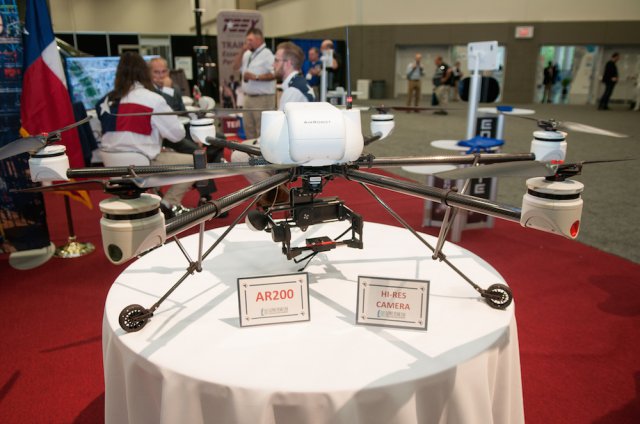
An AR200 by Air Robot, a virtually silent unmanned aerial system, was on display in the Lone Star UAS Center of Excellence and Innovation booth at the AUVSI XPONENTIAL in Dallas in May. It can hover and star with ‘steady eye on target’ with hands-off functionality
Corpus Christi engineers are now working with NASA to develop software to keep drones from colliding with other aircraft, help with emergency landings and sense weather and “no fly” zones, all without the aid of a pilot. The work is part of a new Space Act Agreement signed recently by representatives from NASA Armstrong Flight Research Center, Lone Star UAS Center of Excellence and Innovation (LSUASC) at Texas A&M University-Corpus Christi, and Texas A&M University System.
“This new agreement shows NASA’s continued confidence in the Lone Star UAS Center here at A&M-Corpus Christi,” said Jerry Hendrix, executive director of LSUASC.
Another agreement signed, a Trilateral Memorandum of Agreement, states that the entities involved will work together on an international level to pursue mutually beneficial research. Working with TAMU-CC and the drone center on this project will be the UAS Centre of Excellence (UAS CE), located in Quebec, Canada. UAS stands for unmanned aircraft systems, more commonly known as drones.
“This momentous signing signifies the global impact that unmanned aircraft systems are having across the world,” Hendrix said. “Common research, testing and integration in Canadian Domestic Air Space and in the U.S. National Airspace will be of great benefit to Transport Canada, the FAA and global partners.”
Enabling drones to detect and avoid other aircraft, especially manned aircraft, will help commercialize drones and aid in coming up with common solutions worldwide to address research, testing, training, credentialing and operating unmanned aircraft systems.
The two agreements were signed on the final day of the Texas UAS summit in Dallas in May. The summit occurred alongside AUVSI XPONENTIAL, an annual gathering of the largest global community of leaders in drones, intelligent robotics and unmanned systems.
“This event exhibited the ingenuity and innovative spirit of the Texas A&M University System,” Hendrix said. “It was a great forum held in Texas to expose the Texas A&M University System as a leader in autonomous research and innovation.”
The exhibit theme, “Bringing Autonomous Solutions to America’s Roadways, Railways, Waterways and Skies,” promoted the advancement of UAS technology and research.
As part of the Space Act Agreement, three engineers, including Hunter Morgan and Aaron Hitchcock, will be working with NASA to create the next generation of autonomous UAS technology. Morgan and Hitchcock work at LSUASC and are former graduates of TAMU-CC.
This is the third research project the university has embarked upon with NASA concerning the drone program. It includes receiving access to NASA’s secure information network in 2016 and participation in NASA’s UAS Traffic Management research platform. TAMU-CC is one of only seven FAA-designated test sites in the nation to facilitate testing and research on UAS.
“The UAS community can expect to see Lone Star UAS and our A&M System Partners at the forefront of this emerging technology,” Hendrix said.
Source: Corpus Christi Press Release
